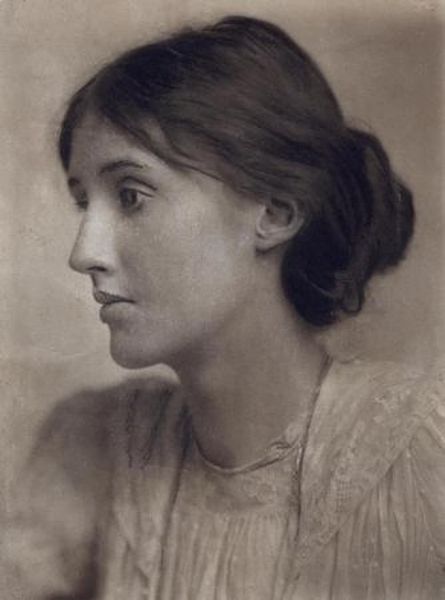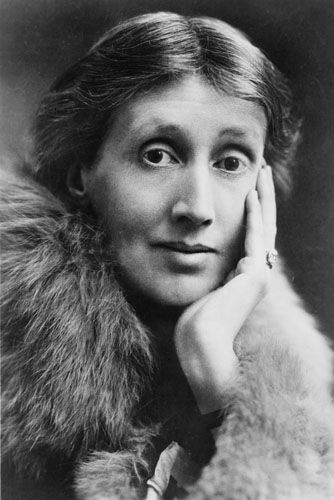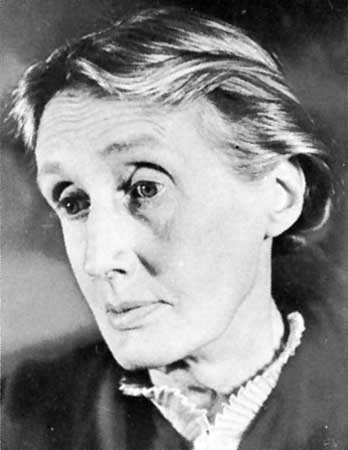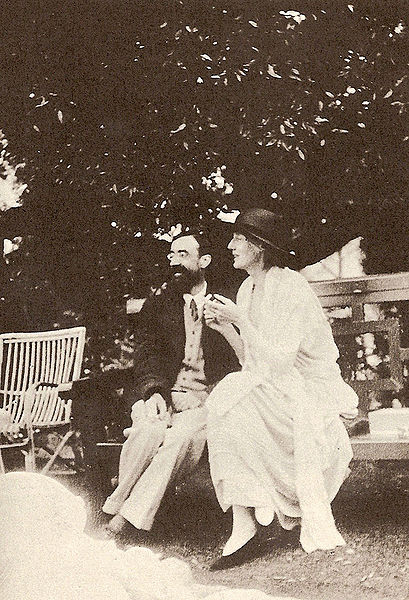<Back to Index>
- Chemist Ilya Romanovich Prigozhin, 1917
- Author Adeline Virginia Woolf, 1882
- General Charles François du Périer Dumouriez, 1739
PAGE SPONSOR



Adeline Virginia Woolf (25 January 1882 – 28 March 1941) was an English author, essayist, publisher, and writer of short stories, regarded as one of the foremost modernist literary figures of the twentieth century.
During the interwar period, Woolf was a significant figure in London literary society and a member of the Bloomsbury Group. Her most famous works include the novels Mrs Dalloway (1925), To the Lighthouse (1927) and Orlando (1928), and the book length essay A Room of One's Own (1929), with its famous dictum, "A woman must have money and a room of her own if she is to write fiction." Virginia Woolf was born Adeline Virginia Stephen in London in 1882. Her mother, a renowned beauty, Julia Prinsep Stephen (born Jackson) (1846 – 1895), was born in India to Dr. John and Maria Pattle Jackson and later moved to England with her mother, where she served as a model for Pre-Raphaelite painters such as Edward Burne-Jones. Her father, Sir Leslie Stephen, was a notable historian, author, critic and mountaineer. The young Virginia was educated by her parents in their literate and well connected household at 22 Hyde Park Gate, Kensington. Her parents had each been married previously and been widowed,
and, consequently, the household contained the children of three
marriages. Julia had three children from her first husband, Herbert Duckworth: George Duckworth, Stella Duckworth, and Gerald Duckworth. Her father Leslie Stephen was
married to Harriet Marian (Minny) Thackeray (1840 – 1875), and they had
one daughter: Laura Makepeace Stephen, who was declared mentally disabled and lived with the family until she was institutionalized in 1891. Leslie and Julia had four children together: Vanessa Stephen (1879), Thoby Stephen (1880), Virginia (1882), and Adrian Stephen (1883). Sir Leslie Stephen's eminence as an editor, critic, and biographer, and his connection to William Thackeray (he
was the widower of Thackeray's youngest daughter), meant that his
children were raised in an environment filled with the influences of Victorian literary society. Henry James, George Henry Lewes, Julia Margaret Cameron (an aunt of Julia Stephen), and James Russell Lowell,
who was made Virginia's honorary godfather, were among the visitors to
the house. Julia Stephen was equally well connected. Descended from an
attendant of Marie Antoinette,
she came from a family of renowned beauties who left their mark on
Victorian society as models for Pre-Raphaelite artists and early
photographers. Supplementing these influences was the immense library
at the Stephens' house, from which Virginia and Vanessa (unlike their
brothers, who were formally educated) were taught the classics and English literature. According to Woolf's memoirs, her most vivid childhood memories, however, were not of London but of St. Ives in Cornwall,
where the family spent every summer until 1895. The Stephens' summer
home, Talland House, looked out over Porthminster Bay, and is still
standing today, though somewhat altered. Memories of these family
holidays and impressions of the landscape, especially the Godrevy Lighthouse, informed the fiction Woolf wrote in later years, most notably To the Lighthouse. The
sudden death of her mother in 1895, when Virginia was 13, and that of
her half-sister Stella two years later, led to the first of Virginia's several nervous breakdowns.
She was, however, able to take courses of study (some at degree level)
in Greek, Latin, German and history at the Ladies’ Department of King’s
College London between 1897 and 1901, and this brought her into contact
with some of the early reformers of women’s higher education such as
Clara Pater, George Warr and Lilian Faithfull (Principal of the King’s
Ladies’ Department). Her sister Vanessa also studied Latin, Italian, art and architecture at King’s Ladies’ Department. The death of her father in 1904 provoked her most alarming collapse and she was briefly institutionalized. Her breakdowns and subsequent recurring depressive periods, modern scholars (including her nephew and biographer, Quentin Bell) have suggested, were also influenced by the sexual abuse she
and Vanessa were subjected to by their half-brothers George and Gerald
Duckworth (which Woolf recalls in her autobiographical essays A Sketch of the Past and 22 Hyde Park Gate). Throughout her life, Woolf was plagued by periodic mood swings and
associated illnesses. Though this instability often affected her social
life, her literary productivity continued with few breaks until her
suicide. After
the death of their father and Virginia's second nervous breakdown,
Vanessa and Adrian sold 22 Hyde Park Gate and bought a house at 46
Gordon Square in Bloomsbury. Woolf came to know Lytton Strachey, Clive Bell, Rupert Brooke, Saxon Sydney-Turner, Duncan Grant, Leonard Woolf and Roger Fry, who together formed the nucleus of the intellectual circle of writers and artists known as the Bloomsbury Group. Several members of the group attained notoriety in 1910 with the Dreadnought hoax, which Virginia participated in disguised as a male Abyssinian royal. Her complete 1940 talk on the Hoax was discovered and is published in the memoirs collected in the expanded edition of The Platform of Time (2008). In 1907 Vanessa married Clive Bell, and the couple's interest in avant garde art would have an important influence on Virginia's development as an author. Virginia Stephen married writer Leonard Woolf in
1912. Despite his low material status (Virginia referring to Leonard
during their engagement as a "penniless Jew") the couple shared a close
bond. Indeed, in 1937, Woolf wrote in her diary: "Love-making — after
25 years can’t bear to be separate ... you see it is enormous pleasure
being wanted: a wife. And our marriage so complete." The two also
collaborated professionally, in 1917 founding the Hogarth Press, which subsequently published Virginia's novels along with works by T.S. Eliot, Laurens van der Post, and others. The Press also commissioned works by contemporary artists, including Dora Carrington and Vanessa Bell. The ethos of the Bloomsbury group discouraged sexual exclusivity, and in 1922, Virginia met the writer and gardener Vita Sackville - West, wife of Harold Nicolson. After a tentative start, they began a sexual relationship that lasted through most of the 1920s. In 1928, Woolf presented Sackville - West with Orlando, a fantastical biography in which the eponymous hero's life spans three centuries and both genders. It has been called by Nigel Nicolson, Vita Sackville - West's son, "the longest and most charming love letter in literature." After
their affair ended, the two women remained friends until Woolf's death
in 1941. Virginia Woolf also remained close to her surviving siblings,
Adrian and Vanessa; Thoby had died of an illness at the age of 26. Woolf began writing professionally in 1900, initially for the Times Literary Supplement with a journalistic piece about Haworth, home of the Brontë family. Her first novel, The Voyage Out, was published in 1915 by her half-brother's imprint, Gerald Duckworth and Company Ltd. This novel was originally entitled Melymbrosia, but Woolf repeatedly changed the draft. An earlier version of The Voyage Out has been reconstructed by Woolf scholar Louise DeSalvo and
is now available to the public under the intended title. DeSalvo argues
that many of the changes Woolf made in the text were in response to
changes in her own life. Woolf
went on to publish novels and essays as a public intellectual to both
critical and popular success. Much of her work was self published
through the Hogarth Press. She has been hailed as one of the greatest novelists of the twentieth century and one of the foremost modernists. Woolf is considered one of the greatest innovators in the English language. In her works she experimented with stream of consciousness and
the underlying psychological as well as emotional motives of
characters. Woolf's reputation declined sharply after World War II, but
her eminence was re-established with the surge of Feminist criticism in the 1970s. Her
work was criticised for epitomizing the narrow world of the
upper middle class English intelligentsia. Some critics judged it to be
lacking in universality and depth, without the power to communicate
anything of emotional or ethical relevance to the disillusioned common
reader, weary of the 1920s aesthetes.
She was also criticized by some as an anti-semite, despite her being
happily married to a Jewish man. This anti-semitism is drawn from the
fact that she often wrote of Jewish characters in stereotypical
archetypes and generalizations, including describing some of her Jewish
characters as physically repulsive and dirty. The
overwhelming and rising 1920s and 30s anti-semitism possibly influenced
Virginia Woolf. She wrote in her diary, "I do not like the Jewish
voice; I do not like the Jewish laugh." However, in a 1930 letter to
the composer, Ethel Smyth, quoted in Nigel Nicolson's biography,Virginia Woolf, she
recollects her boasts of Leonard's Jewishness confirming her snobbish
tendencies, "How I hated marrying a Jew - What a snob I was, for they
have immense vitality." In another letter to her dear friend Ethel Smyth, Virginia gives a scathing denunciation of Christianity, seeing it as self-righteous "egotism" and stating "my Jew has more religion in one toe nail — more human love, in one hair." Virginia and her husband Leonard Woolf actually hated and feared 1930s fascism with its anti-semitism knowing they were on Hitler's blacklist. Her 1938 book Three Guineas was an indictment of fascism. Virginia
Woolf's peculiarities as a fiction writer have tended to obscure her
central strength: Woolf is arguably the major lyrical novelist in the
English language. Her novels are highly experimental: a narrative,
frequently uneventful and commonplace, is refracted — and sometimes
almost dissolved — in the characters' receptive consciousness. Intense
lyricism and stylistic virtuosity fuse to create a world overabundant
with auditory and visual impressions. The
intensity of Virginia Woolf's poetic vision elevates the ordinary,
sometimes banal settings – often wartime environments – of most of her
novels. For example, Mrs Dalloway (1925)
centres on the efforts of Clarissa Dalloway, a middle aged society
woman, to organize a party, even as her life is paralleled with that of
Septimus Warren Smith, a working class veteran who has returned from
the First World War bearing deep psychological scars. To the Lighthouse (1927)
is set on two days ten years apart. The plot centers around the Ramsay
family's anticipation of and reflection upon a visit to a lighthouse
and the connected familial tensions. One of the primary themes of the
novel is the struggle in the creative process that beset painter Lily
Briscoe while she struggles to paint in the midst of the family drama.
The novel is also a meditation upon the lives of a nation's inhabitants
in the midst of war, and of the people left behind. It also explores
the passage of time, and how women are forced by society to allow men
to take emotional strength from them. Orlando (1928)
has a different quality from all Virginia Woolf's other novels
suggested by its subtitle, "A Biography", as it attempts to represent
the character of a real person and is dedicated to Vita Sackville - West.
It was meant to console Vita for being a girl and for the loss of her
ancestral home, though it is also a satirical treatment of Vita and her
work. In Orlando the techniques of historical biographers are being
ridiculed; the character of a pompous biographer is being assumed in
order for it to be mocked. The Waves (1931)
presents a group of six friends whose reflections, which are closer to
recitatives than to interior monologues proper, create a wave-like
atmosphere that is more akin to a prose poem than to a plot centered novel. Her last work, Between the Acts (1941)
sums up and magnifies Woolf's chief preoccupations: the transformation
of life through art, sexual ambivalence, and meditation on the themes
of flux of time and life, presented simultaneously as corrosion and
rejuvenation — all set in a highly imaginative and symbolic narrative
encompassing almost all of English history. This book is the most
lyrical of all her works, not only in feeling but in style, being
chiefly written in verse. While Woolf's work can be understood as consistently in dialogue with Bloomsbury, particularly its tendency (informed by G.E. Moore, among others) towards doctrinaire rationalism, it is not a simple recapitulation of the coterie's ideals. Her works have been translated into over 50 languages, by writers such as Jorge Luis Borges and Marguerite Yourcenar. After completing the manuscript of her last (posthumously published) novel, Between the Acts, Woolf fell into a depression similar to that which she had earlier experienced. The onset of World War II, the destruction of her London home during the Blitz, and the cool reception given to her biography of her late friend Roger Fry all worsened her condition until she was unable to work. On 28 March 1941, Woolf put on her overcoat, filled its pockets with stones, and walked into the River Ouse near her home and drowned. Woolf's body was not found until 18 April 1941. Her husband buried her cremated remains under an elm in the garden of Monk's House, their home in Rodmell, Sussex. In her last note to her husband she wrote: Recently, studies of Virginia Woolf have focused on feminist and lesbian themes in her work, such as in the 1997 collection of critical essays, Virginia Woolf: Lesbian Readings, edited by Eileen Barrett and Patricia Cramer. Controversially, Louise A. DeSalvo reads
most of Woolf's life and career through the lens of the incestuous
sexual abuse Woolf suffered as a young woman in her 1989 book Virginia Woolf: The Impact of Childhood Sexual Abuse on her Life and Work. Woolf's fiction is also studied for its insight into shell shock, war, class and modern British society. Her best known nonfiction works, A Room of One's Own (1929) and Three Guineas (1938),
examine the difficulties female writers and intellectuals face because
men hold disproportionate legal and economic power and the future of
women in education and society. Irene Coates's book Who's Afraid of Leonard Woolf: A Case for the Sanity of Virginia Woolf holds
that Leonard Woolf's treatment of his wife encouraged her ill health
and ultimately was responsible for her death. This is not accepted by
Leonard's family but is extensively researched and fills in some of the
gaps in the traditional account of Virginia Woolf's life. Victoria
Glendinning's book Leonard Woolf: A Biography,
which is even more extensively researched and supported by
contemporaneous writings, argues that Leonard Woolf was not only
supportive of his wife but enabled her to live as long as she did by
providing her with the life and atmosphere she needed to live and
write. Accounts of Virginia's supposed anti-semitism (Leonard was
atheist) are not only taken out of historical context but greatly
exaggerated. Virginia's own diaries support this view of the Woolfs'
marriage. Though
at least one biography of Virginia Woolf appeared in her lifetime, the
first authoritative study of her life was published in 1972 by her
nephew Quentin Bell. In 1992, Thomas Caramagno published the book The Flight of the Mind: Virginia Woolf's Art and Manic-Depressive Illness." Hermione Lee's 1996 biography Virginia Woolf provides a thorough and authoritative examination of Woolf's life and work. In 2001 Louise DeSalvo and Mitchell A. Leaska edited The Letters of Vita Sackville - West and Virginia Woolf. Julia Briggs's Virginia Woolf: An Inner Life,
published in 2005 is the most recent examination of Woolf's life. It
focuses on Woolf's writing, including her novels and her commentary on
the creative process, to illuminate her life. Thomas Szasz's book My Madness Saved Me: The Madness and Marriage of Virginia Woolf was published in 2006. Rita Martin’s play Flores no me pongan (2006)
considers Woolf's last minutes of life in order to debate polemical
issues such as bisexuality, Jewishness and war. Written in Spanish, the
play was performed in Miami under the direction of actress Miriam Bermudez.
“ I
feel certain that I am going mad again. I feel we can't go through
another of those terrible times. And I shan't recover this time. I
begin to hear voices, and I can't concentrate. So I am doing what seems
the best thing to do. You have given me the greatest possible
happiness. You have been in every way all that anyone could be. I don't
think two people could have been happier 'til this terrible disease
came. I can't fight any longer. I know that I am spoiling your life,
that without me you could work. And you will I know. You see I can't
even write this properly. I can't read. What I want to say is I owe all
the happiness of my life to you. You have been entirely patient with me
and incredibly good. I want to say that — everybody knows it. If
anybody could have saved me it would have been you. Everything has gone
from me but the certainty of your goodness. I can't go on spoiling your
life any longer. I don't think two people could have been happier than
we have been. V. ”
